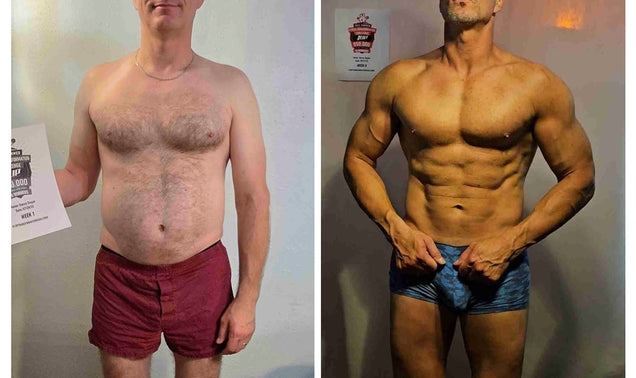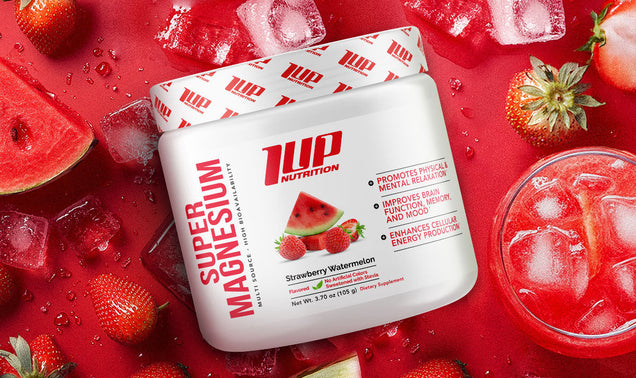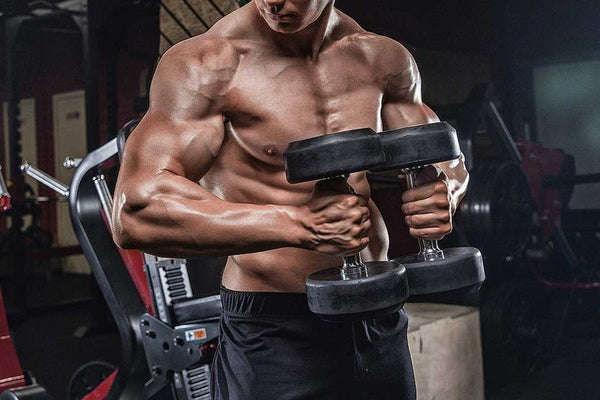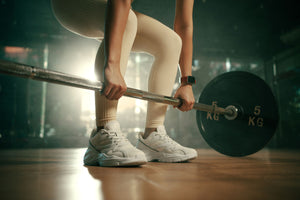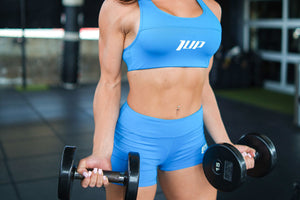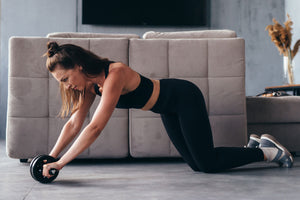The number of exercises you can do to work your chest is simply mind-numbing. There are dozens, if not well over a hundred, of different exercises you can perform to work the pecs.
In fact, we’ve got just about every exercise imaginable listed in the 1UP Fitness App, which is available for FREE on both iTunes and Google Play.
But, if you’re reading this, you’re interested in knowing all of the exercises you can do. You want to know what are the most effective chest exercises to perform, so you can maximize your results during your transformation challenge.
Well, you’re in luck, because today we’re giving you our top 10 best chest workout exercises for building muscle!
#1 Dumbbell Bench Press
A great many of you reading this probably expected to see the barbell bench press as the #1 exercise on this list, and you’d have a formidable argument. The barbell bench press is a staple exercise for many individuals seeking to build muscle and strength.
But, we’ve gone with the dumbbell bench press as the #1 exercise for a couple of reasons:
First, the dumbbell bench press allows for a greater range of motion, which means your chest muscles have to do more work, promoting greater hypertrophy.
Second, using dumbbells allows you to find the optimal hand and elbow placement that’s optimal for your body and biomechanics. The barbell locks you into a fixed path, and this can lead to stress on the shoulders, wrists, and/or elbows for some individuals.
Third, dumbbells force both sides of your body to work independently, which helps attenuate any imbalances that may develop (as we all have a dominant and non-dominant side).
Fourth, dumbbells may offer a more accessible option to learning pressing movements with weights as some individuals may be anxious about using a barbell if they’re not used to resistance training.
#2 Incline Dumbbell Bench Press
The flat dumbbell press is a phenomenal exercise for building the chest. It hits all major areas of the pectorals, but focuses primarily on the sternocostal fibers (middle) of the chest.
The incline dumbbell bench press hits the entire chest, but places greater emphasis on the upper portion (clavicular head) of the pecs, which is an area that’s often lagging in both men and women.
Including both variations is a great way to hit the chest from different angles promoting greater overall muscle and strength development.
#3 Barbell Bench Press
As mentioned above, the barbell bench press is a phenomenal exercise for building raw power and strength as it allows for the greatest amount of weight to be used of any of the chest exercises on this list.
It can be used across a variety of rep schemes and rep ranges, from lower rep protocols (5x5) to high volume ones (10x10).
Since it’s a compound movement and requires a good deal of concentration, stability, and strength, it’s a good idea to keep the barbell bench press towards the beginning of your workout (1st, 2nd, or 3rd exercise) when you’re fresher mentally and physically.
#4 Incline Barbell Bench Press
Like we discussed with the incline dumbbell bench press, pressing on an incline allows you to bias the upper pecs compared to the flat barbell bench press, which emphasizes the middle chest fibers.
Make sure to use a slight incline when doing the dumbbell or barbell bench press (somewhere between 10-45 degrees). Using too steep of an incline (greater than 45-degrees) shifts more of the tension onto the shoulders, which is fine if you’re wanting to train shoulders, but less than ideal if you’re looking to build a strong chest.
#5 Machine Chest Press
There’s a never-ending debate as to which is better for building muscle -- free weights or machines.
The truth is that both can be extremely effective for building muscle and strength. The best muscle-building programs, like those included in the 1UP Fitness App, include a variety of exercises, which has been shown in research to promote greater muscle building than only using one or two exercises.
Another benefit of machines is that they require less stabilization, allowing you to really focus on a strong mind-muscle connection and hammer the target muscle.
For individuals with a history of injury or those who are just entering the world of resistance training, machine-based exercises may provide a more accessible/inviting option.
Additionally, since machine exercises are less demanding to the muscles and nervous system than free weight exercises, they are best suited to the latter portion of your workouts, after the heavy, compound, free weight exercises are done.
#6 Push Ups
Before the invention of barbells, dumbbells, and weight plates, humans built strong chests with a steady mix of bodyweight exercises including push ups and dips (the next exercise on this list of the best chest workout exercises for building muscle).
Simply put, push ups have stood the test of time as one of the best exercises for building strength and learning how to control your body through space. The best thing is that push ups require no gym memberships or equipment. You can do them any time, any where, making it an ideal option to include in your chest workouts whether you’re training at the gym, at home, or on the road.
Many individuals eschew the push up after they gain a relatively decent amount of strength, but the truth is that there are a seemingly endless variety of push ups you can do to challenge your muscles and continue to get results.
Some of our favorite muscle-building push up variations include:
- Decline push ups
- Deficit push ups
- Archer push ups
- 1-½ rep push ups
- Assisted one arm push ups
- Dive bomber push ups
Another great thing about push ups is that they can be inserted any place in your workout, as they can be used to build strength and they can also be used as a “finisher” at the end to really deplete glycogen and finish off the chest muscles.
#7 Dips
Similar to the push up, the dip has been a staple for decades in helping individuals of all walks build a stronger upper body.
Dips place a tremendous stretch on the pecs, which makes it a great movement for overloading the pecs and promoting hypertrophy.
Like other bodyweight exercises (including push ups), external loading (e.g. a dip belt) can be added to dips to increase the challenge and continue to get results without having to use a barbell.
In addition to adding external weight, you can also increase the challenge of the dip by pausing at the bottom of the rep and/or doing 1-½ reps.
One important thing to keep in mind (and the same goes for push ups), is to not “bounce” out of the bottom (stretch) position. This places more stress on your joints, ligaments and connective tissue, and it actually reduces the amount of work that your muscles are doing, which is the exact opposite of what you want when trying to build muscle.
For added chest emphasis on the dip, perform the movement with a slight forward lean and lead with your chest.
#8 Dumbbell Floor Press
The dumbbell floor press is a great option to hit the major pressing muscles of the body (including the chest), especially for those who may not have access to a bench as well as those who experience shoulder stress with conventional pressing on a bench.
The reason the floor press is great for individuals with shoulder issues is that the floor limits the amount of shoulder extension that can occur, reducing the amount of stress on the shoulder joint.
And, since you’re using dumbbells, you’ll be able to find the right position for your hands, wrists, and elbows that best for your anatomy and anthropometry to help maximize muscle recruitment and minimize joint stress and irritation.
#9 Cable Crossover
Besides the free weights vs machines debate that always seems to be happening, another equally contentious issue is compound vs isolation exercises for muscle building.
As was the case before, it’s not a binary proposition, meaning it doesn’t have to be one or the other (all compound and no isolation or all isolation and no compound exercises). The best results come from using a mix.
Isolation exercises allow you to really burn out a target muscle when your supporting stabilizer muscle groups may be fatigued. For instance, after your heavy pressing movements, the shoulders and triceps could be extremely fatigued, but the chest may still have a bit of “juice” left in it. Isolation exercises allow you to hammer a target muscle group to really burn out the fibers.
Additionally, there’s only so many compound exercises you can do in a workout before central fatigue kicks in. Isolation exercises are less stressful to the nervous system and joints, allowing you to get in more training volume without excessive stress to the supporting structures and nervous system.
And, when it comes to isolation exercises for the chest, the cable crossover is one of the absolute best!
By using the cables, you get the benefit of constant tension throughout the entire range of motion. Dumbbell flyes are a great option for isolating the chest, but there’s essentially no tension on the fibers of the chest muscles at the top of the movement. This issue is solved with the cable crossover.
#10 Pec Dec (Machine Fly)
Last, but certainly not least, is another isolation exercise -- the machine chest fly (aka pec dec).
Like the cable crossover, the machine fly is a more optimal chest isolation exercise for placing a tremendous stretch on the pecs, without compromising the shoulder joint. It also has the benefit of constant tension on the pecs due to the use of cables.
The pec dec is typically used as a finisher at the end of a chest or push workout, but it can also be used as a warm-up or pre-exhaust movement at the beginning of your workout to help establish the mind-muscle connection.
Takeaway
We’ve covered 10 of the best chest workout exercises for building muscle.
Now, you don’t need to include all 10 exercises in a single workout in order to build muscle and strength, but you should include 3-4 of them for optimal chest development as a variety of exercises allow you to train the chest from multiple angles and force vectors.
If you need help figuring out which exercises are best for your body type and equipment selection, make sure to check out the FREE 1UP Fitness App, which provides customized training plans. Within the app, you’ll also be able to track your calories and macros as well as receive suggestions on foods and meals to eat to help you stay on track with your goals and get the best results possible during your transformation challenge!
And, after your workout is over, don’t forget to kickstart the recovery process by having a much-deserved scoop of 1UP whey protein powder!

